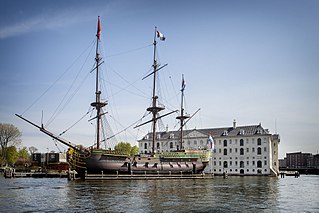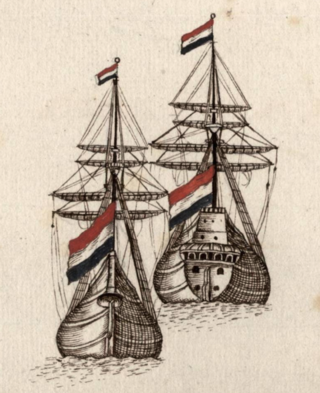
Batavia ( ) was a ship of the Dutch East India Company (VOC). She was built in Amsterdam in 1628 as the flagship of one of the three annual fleets of company ships and sailed that year on her maiden voyage for Batavia, capital of the Dutch East Indies. On 4 June 1629, Batavia was wrecked on the Houtman Abrolhos, a chain of small islands off Western Australia.

The Amsterdam was an 18th-century cargo ship of the Dutch East India Company. The VOC was established in 1602. The ship started its maiden voyage from Texel to Batavia on 8 January 1749, but was wrecked in a storm on the English Channel on 26 January 1749. The shipwreck was discovered in 1969 in the bay of Bulverhythe, near Hastings on the English south coast, and is sometimes visible during low tides. The location in 1969 was found by Bill Young, the site agent/project manager for the sewage outfall being built by the William Press Group. With time on his hands during the long stay away from home, he followed up the rumour of the going aground. He was castigated by the Museum of London for scooping out the interior of the bow with a digger as it could have led to the structure collapsing. However, it uncovered the initial items which led to a more extensive excavation of the cargo which reflected life at the time. The wreck is a Protected Wreck managed by Historic England. Some of the findings from the site are in The Shipwreck Museum in Hastings. A replica of the ship is on display in Amsterdam.
Francisco Pelsaert was a Dutch merchant who worked for the Dutch East India Company best known for his role as the commander of the Batavia. The ship ran aground in the Houtman Abrolhos, off the coastal regions of Western Australia in June 1629, which led to a massacre of survivors orchestrated by Jeronimus Cornelisz.
Jeronimus Cornelisz was a Dutch apothecary and Dutch East India Company merchant who sailed aboard the merchant ship Batavia which foundered near the Australian mainland. Cornelisz then led one of the bloodiest mutinies in history.
Ridderschap van Holland was a large retourschip, the largest class of merchantmen built by the Dutch East India Company to trade with the East Indies. In 1694 the ship sailed for Batavia on her fifth voyage, but was never heard from again. She is now thought to have been shipwrecked off the west coast of Australia.

The Zeewijk was an 18th-century East Indiaman of the Dutch East India Company that was shipwrecked at the Houtman Abrolhos, off the coast of Western Australia, on 9 June 1727. The survivors built a second ship, the Sloepie, enabling 82 out of the initial crew of 208 to reach their initial destination of Batavia on 30 April 1728. Since the 19th century many objects were found near the wreck site, which are now in the Western Australian Museum. The shipwreck itself was found in 1968 by divers.
't Wapen van Hoorn was a 17th-century Dutch East India Company fluyt with a tonnage between 400 and 600, built in the Dutch Republic in 1619. During its second voyage it grounded on the west coast of Australia, making it about the tenth ship to make landfall on Australian soil, and following Tryall just a few weeks earlier only the second ship to be shipwrecked in Australian waters, albeit temporarily.
Vianen was a 17th-century Dutch East Indies Company sailing ship, used to transport cargo between Europe and the Indies. She was shipwrecked but refloated on her first voyage, and shipwrecked and sunk on her second. Built at Amsterdam in 1626, she had a gross tonnage of 400.
Fortuyn was a ship owned by the Chamber of Amsterdam of the Dutch East India Company that was lost on its maiden voyage in 1723. It set sail for Batavia from Texel in the Netherlands on 27 September 1723. The ship reached the Cape of Good Hope on 2 January 1724, and continued on its voyage on 18 January. Fortuyn was never seen again and its fate is a matter of speculation.
Aagtekerke was a ship of the Dutch East India Company built in 1724. It was lost without trace during its maiden voyage in 1725–26, sailing from Cape of Good Hope in the Dutch Cape Colony to Batavia in the Dutch East Indies.

Pieter de Bitter was a 17th-century Dutch officer of the Dutch East India Company. On 12 August 1665 he won the Battle of Vågen against an English flotilla commanded by Thomas Teddeman.
Thirteen ships of the Dutch East India Company and its pre-companies have been named Amsterdam.

Wiebbe Hayes was a Dutch soldier known for his leading role in the suppression of Jeronimus Cornelisz's massacre of shipwreck survivors in 1629, after the merchant ship Batavia was wrecked in the Houtman Abrolhos, a chain of coral islands off the west coast of Australia.
Lucretia Jans, or Lucretia van der Mijlen, was a survivor of the events that followed the sinking of the Batavia in 1629.
Wouter Loos was a soldier on board the Dutch East India Company ship Batavia, which sank on Morning Reef in the Wallabi Group of the Houtman Abrolhos Islands off the coast of Western Australia in 1629. Loos had a critical role in the subsequent Batavia Mutiny, becoming the leader of the mutiny after the original leader, Jeronimus Cornelisz (Corneliszoon), was captured.
Haasje was built at Amsterdam in 1788 as a packet for the Dutch East India Company (VOC). She made three or probably four voyages between Texel and Batavia. A British whaler captured her in August 1797 as she was on a secret mission from Batavia to arm Dutch farmers in the Cape Colony to stir up difficulties for the British. She sailed to Britain and a French privateer captured her shortly before she arrived. She was quickly recaptured. She became a merchantman sailing between London and Dartmouth, and then London and Africa. She was last listed in 1806.
The Leeuwin was a 400-ton jacht of the Dutch East India Company that travelled to the East Indies twice starting 3 April 1653. It wrecked near Macassar on 24 December 1664.

Candia was a ship of the Dutch East India Company which only once traveled for Asia in 1790 and never returned to the Netherlands.
Constantia was launched in 1782 at the Delft Shipyard as an East Indiaman for the Delft Chamber of the Dutch East India Company (VOC). The British Royal Navy captured her in 1795 when the British occupied Malacca.

Heemskerck was the flagship of Abel Janszoon Tasman's exploratory voyage of 1642. She and her consort Zeehaen were the first European ships to explore the south coast of Australia, including Tasmania, cross the Tasman Sea, and reach New Zealand among other achievements.








